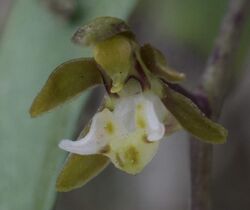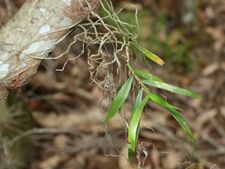Biology:Plectorrhiza tridentata
| Common tangle orchid | |
|---|---|

| |
| Plectorrhiza tridenta growing near Nowra | |
| Scientific classification | |
| Kingdom: | Plantae |
| Clade: | Tracheophytes |
| Clade: | Angiosperms |
| Clade: | Monocots |
| Order: | Asparagales |
| Family: | Orchidaceae |
| Subfamily: | Epidendroideae |
| Genus: | Plectorrhiza |
| Species: | P. tridentata
|
| Binomial name | |
| Plectorrhiza tridentata (Lindl.) Dockrill[1]
| |
| Synonyms[1] | |
| |
Plectorrhiza tridentata, commonly known as the common tangle orchid,[2] is an epiphytic or lithophytic orchid that has many coarse, tangled roots, up to twenty egg-shaped leaves and up to fifteen green or brown, star-shaped flowers with a white labellum. It grows on rainforest trees and in other humid places and occurs between the Daintree National Park in Queensland and the far north-eastern corner of Victoria.
Description
Plectorrhiza tridentata is an epiphytic or lithophytic herb with a single main flattened stem, 100–300 millimetres (3.9–12 in) long suspended by one to a few of its many tangled aerial roots. There are between three and twenty green to purplish, leathery, narrow egg-shaped leaves 50–100 millimetres (2.0–3.9 in) long and 10–15 millimetres (0.39–0.59 in) wide. Between three and fifteen green or brown flowers, 5–6 millimetres (0.20–0.24 in) long and 6–8 millimetres (0.24–0.31 in) wide are borne on a pendulous flowering stem 50–120 millimetres (2.0–4.7 in) long. The sepals and petals are free from each other and spread widely apart. The dorsal sepal is 4–5 millimetres (0.16–0.20 in) long, about 2 millimetres (0.079 in) wide and the lateral sepals are slightly longer. The petals are 4–5 millimetres (0.16–0.20 in) long, about 1.5 millimetres (0.059 in) wide. The labellum is white with a green patch, 6–7 millimetres (0.24–0.28 in) long, about 4 millimetres (0.16 in) wide with three lobes. The side lobes are more or less triangular and curve outwards and the middle lobe is blunt with a curved spur about 2 millimetres (0.079 in) long. Flowering occurs from September to January.[2][3][4][5][6]
Taxonomy and naming
The common tangle orchid was first formally described in 1838 by John Lindley who gave it the name Cleisostoma tridentatum and published the description in Edwards's Botanical Register.[7][8] In 1967 Alick Dockrill changed the name to Plectorrhiza tridentata.[9] The specific epithet (tridentata) is derived from the Latin word tridens meaning "a fork with three tines".[10]
Distribution and habitat
Plectorrhiza tridentata usually grows on trees in humid places such as deep gullies and swamps. It is found in from the Daintree area in Queensland south along the coast and nearby ranges of New South Wales to rainforest east of the Snowy River in north-eastern Victoria.[2][3][5][6]
References
- ↑ 1.0 1.1 "Plectorrhiza tridentata". World Checklist of Selected Plant Families (WCSP). Royal Botanic Gardens, Kew. http://wcsp.science.kew.org/namedetail.do?name_id=157857.
- ↑ 2.0 2.1 2.2 Jones, David L. (2006). A complete guide to native orchids of Australia including the island territories. Frenchs Forest, N.S.W.: New Holland. p. 442. ISBN 1877069124.
- ↑ 3.0 3.1 "Factsheet - Plectorrhiza tridentata". Centre for Australian National Biodiversity Research (CANBR), Australian Government. 2010. http://www.canbr.gov.au/cpbr/cd-keys/RFKOrchids/key/rfkorchids/Media/Html/Plectorrhiza_tridentata.htm.
- ↑ Les Robinson – Field Guide to the Native Plants of Sydney, ISBN:978-0-7318-1211-0 page 264
- ↑ 5.0 5.1 Weston, Peter H.. "Plectorrhiza tridentata". Royal Botanic Garden Sydney. http://plantnet.rbgsyd.nsw.gov.au/cgi-bin/NSWfl.pl?page=nswfl&lvl=sp&name=Plectorrhiza~tridentata. Retrieved 28 December 2018.
- ↑ 6.0 6.1 Jeanes, Jeff. "Plectorrhiza tridentata". Royal Botanic Gardens Victoria. https://vicflora.rbg.vic.gov.au/flora/taxon/0fd475c9-34b4-4890-beab-ca5da89da832. Retrieved 28 December 2018.
- ↑ "Cleisostoma tridentatum". APNI. https://id.biodiversity.org.au/instance/apni/482384. Retrieved 28 December 2018.
- ↑ Lindley, John (1838). "Cleisostoma tridenticulatum". Edwards's Botanical Register 24: 33. https://www.biodiversitylibrary.org/ia/mobot31753002748363#page/240/mode/1up. Retrieved 28 December 2018.
- ↑ "Plectorrhiza tridentata". APNI. https://id.biodiversity.org.au/instance/apni/498483. Retrieved 28 December 2018.
- ↑ Brown, Roland Wilbur (1956). The Composition of Scientific Words. Washington, D.C.: Smithsonian Institution Press. p. 345.
Wikidata ☰ Q15486854 entry
 |


